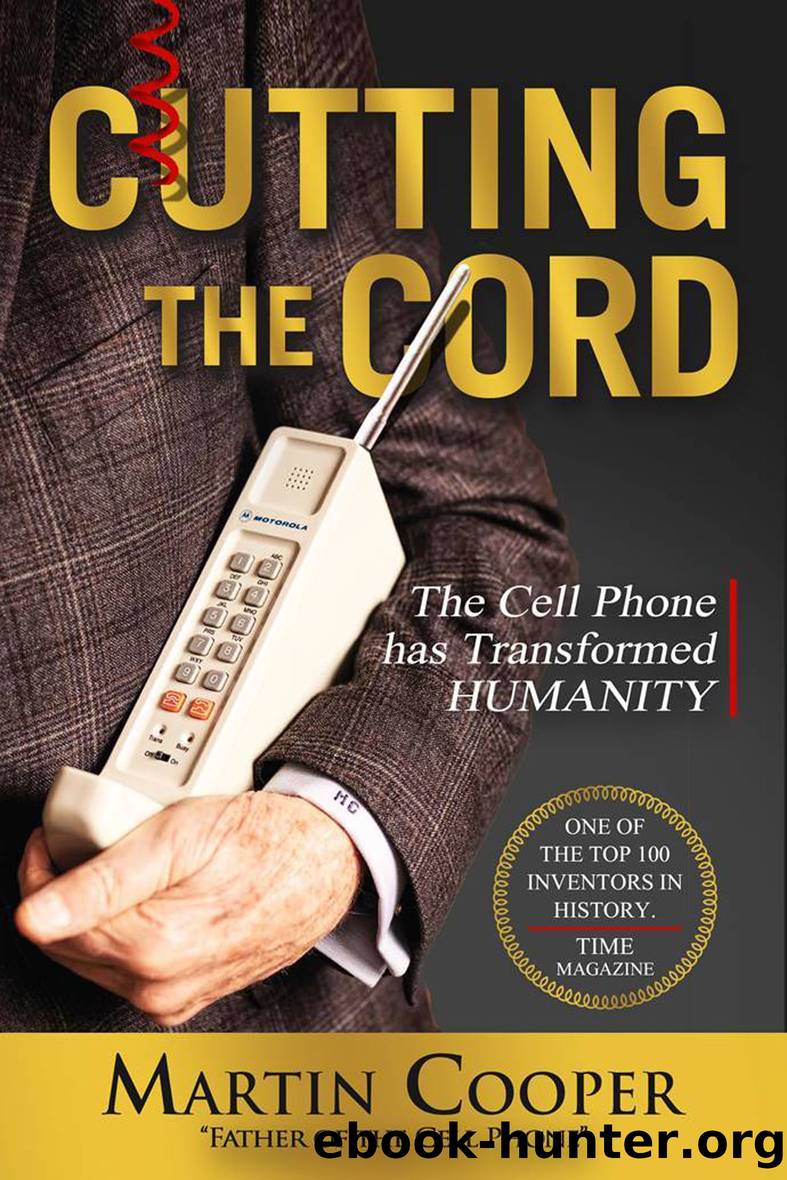Cutting The Cord: The Cell Phone Has Transformed Humanity by Martin Cooper

Author:Martin Cooper [Cooper, Martin]
Language: eng
Format: epub
Publisher: RosettaBooks LLC
Published: 2020-02-15T00:00:00+00:00
In the middle of March 1973, I was busy preparing my testimony for the upcoming FCC hearing while also trying to keep tabs on our crash project. Don Linder called me into his lab. The original âshoeâ prototype designed by Ken Larson had been relatively small, comparable even to todayâs cell phones. Because Donâs team had to stuff it with about a thousand parts to meet my specifications, the phone grew and grew. We knew the original model would need to stretch to give the electrical engineers room for their parts, but I had no idea just how much stretching would be needed.
Larsonâs original model had been a half-inch wide, a few inches deep, several inches long, and incredibly light. Now, after being made to accommodate all the necessary parts, Don showed me a phone that was ten inches long, three inches wide, weighed two and a half pounds, and had a six-inch antenna atop it. That was still far lighter than AT&Tâs thirty-pound car phone systemâmanufactured, admittedly, by Motorolaâthat they wanted to put in more vehicles.
The âshoe phoneâ now came to be called âthe brickâ because of its size and shape. It could access nearly four hundred radio channels, and the battery could handle about a dozen three-minute calls, lasting up to twelve hours in standby mode.7
In just three months, dedicated individuals and teams had created not only a new communications device but also the system of switching equipment and radio stations that, together, would transform the world. The patent that we ultimately secured from the US governmentâfor integration of new and different components and ideasâhas Martin Cooper as the first listed inventor. But my idea would have been worthless without the expertise and experience that made it real. We had integrated various pieces and components into an entirely new system, not just a product. I came up with the name DynaTAC for our new phone, an abbreviation of DYNamic Adaptive Total Area Coverage, to describe Motorolaâs approach to cellular technology.
Motorolaâs patent for a âRadio Telephone System,â filed October 17, 1973 and granted September 16, 1975. This was the DynaTAC system patent for a wireless telephone system accommodating truly handheld, portable phones. United States Patent and Trademark Office 3,906,166.
Roy Richardson later told me, âMarty, you persuaded us to do things we never imagined we could accomplish.â
By the third week of March, after assembling a new version of the phone with tighter packing, we had a complete unit ready to show John Mitchell. Though he had been keeping tabs on our work, John had never seen the complete unit. He was entranced. He immediately called Jerry Orloff, head of public relations for the Communications Division. We had a demonstration to plan.
Download
This site does not store any files on its server. We only index and link to content provided by other sites. Please contact the content providers to delete copyright contents if any and email us, we'll remove relevant links or contents immediately.
| Automotive | Engineering |
| Transportation |
Whiskies Galore by Ian Buxton(41525)
Introduction to Aircraft Design (Cambridge Aerospace Series) by John P. Fielding(32885)
Small Unmanned Fixed-wing Aircraft Design by Andrew J. Keane Andras Sobester James P. Scanlan & András Sóbester & James P. Scanlan(32570)
Craft Beer for the Homebrewer by Michael Agnew(17928)
Turbulence by E. J. Noyes(7694)
The Complete Stick Figure Physics Tutorials by Allen Sarah(7135)
Kaplan MCAT General Chemistry Review by Kaplan(6591)
The Thirst by Nesbo Jo(6432)
Bad Blood by John Carreyrou(6271)
Modelling of Convective Heat and Mass Transfer in Rotating Flows by Igor V. Shevchuk(6219)
Learning SQL by Alan Beaulieu(6029)
Weapons of Math Destruction by Cathy O'Neil(5824)
Man-made Catastrophes and Risk Information Concealment by Dmitry Chernov & Didier Sornette(5643)
Digital Minimalism by Cal Newport;(5388)
Life 3.0: Being Human in the Age of Artificial Intelligence by Tegmark Max(5182)
iGen by Jean M. Twenge(5158)
Secrets of Antigravity Propulsion: Tesla, UFOs, and Classified Aerospace Technology by Ph.D. Paul A. Laviolette(4980)
Design of Trajectory Optimization Approach for Space Maneuver Vehicle Skip Entry Problems by Runqi Chai & Al Savvaris & Antonios Tsourdos & Senchun Chai(4837)
Electronic Devices & Circuits by Jacob Millman & Christos C. Halkias(4743)
